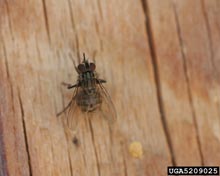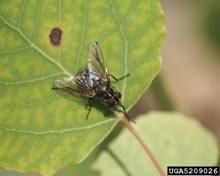
Whitney Crenshaw, Colorado State University

Whitney Crenshaw, Colorado State University
Stable Fly
General Descriptions
The stable fly is a about one-fourth of an inch long and gray with four dark stripes on its thorax (behind the head).
This fly looks like a house fly, except for the pointed proboscis beneath its head through which it sucks blood.
They are most abundant in late summer and fall, and will fly several miles to bite livestock (hence the name),
pets and people. They typically bite in early morning or late afternoon and often attack the ankles, inflicting a
sharp, stabbing pain. Stable flies lay eggs in piles of rotting vegetable matter, such as haystacks, grass clippings,
manure and vegetation along shorelines. Like the adults, stable fly larvae are nearly identical to the larvae of
house flies.
General Control
Area-wide control of biting flies can be difficult due to the hidden habitats in which the larvae are found, and
because some adult biting flies fly miles from their larval habitats. Nevertheless, sanitation can be an important
means of controlling some biting flies. The larvae of stable flies, for example, develop in piles of decaying hay,
straw and other vegetation, including manure containing plant matter. These potential sites for larval development
should be eliminated where practical. Barriers such as screening not less than 16-mesh, and tight-fitting, selfclosing
doors that are kept closed when not in use will help reduce the number of flies entering structures.
While the use of pesticides is usually not the best means of managing filth fly problems, sometimes chemical control can be a valuable component of an integrated fly management program. This type of control often provides only temporary relief, however, and cannot be relied upon to eliminate the problem.









